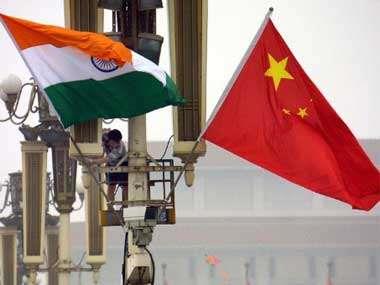April 4, 2013
By Special Correspondent & Columnist, Sam Prasad Jillella
ADELPHI, MD. — I enjoyed Holi a lot, growing up in India. What I really enjoyed most was watching the fun the revelers had.

Celebrators smear each other with colors, in good humor, welcoming the spring season
April 4, 2013
By Special Correspondent & Columnist, Sam Prasad Jillella
ADELPHI, MD. — I enjoyed Holi a lot, growing up in India. What I really enjoyed most was watching the fun the revelers had.

Celebrators smear each other with colors, in good humor, welcoming the spring season
I was at the Hindu Temple of Washington DC on the evening of March 30, watching the Indian and Trinidadian communities have so much fun.

Hindu Temple of Metropolitan Washington – Adelphi, Maryland
Gosh! They had a blast! It took me right back to India, to my middle school days, in Bangalore and Hyderabad.
Holi has religious origins, but the festival does not involve much religious activity. It calls for merry-making.

Ring Bang Tassa Group of Baltimore, MD: Heart pounding drum beats that electrified the revelers
Holi, the festival of colors is celebrated in India, Nepal, and in countries with sizable populations of the Indian diaspora. I have observed Hindus from Caribbean nations in the US celebrate Holi with gusto and full of exuberance.

Bobby Seenath, President of the Brahma Vidya Peetham, Trinidadian Hindu Temple, in Nokesville, VA: “I wish you ‘A Happy New Year’ and all the blessings you deserve”
Holi is now immensely popular in America, among communities of South Asian ancestry. According to the Hindu Religious calendar, Holi in 2013 was on Wednesday, March 27. But, in the US, most Indian festivals are celebrated on weekends, and the Hindu Temple had scheduled it for Saturday evening, March 30.
Holi is celebrated to welcome the colorful spring season, and marks the beginning of the Hindu New Year.

Holi celebration in the Hindu Temple Community Hall: Children dancing to Bollywood tunes
MYTHOLOGICAL BASIS OF HOLI
The mythological origins of Holi vary in different parts of South Asia. Let us look at some of the most popular legends.
The main legend is that of Prahlad and his aunt Holika. The demon-king Hiranyakashyap, believing he was the ruler of the universe, considered himself higher than all gods, and ordered everyone to worship him alone. His son, Prahlad refused to worship anyone, except God Vishnu.

Holika, though immune to fire, was reduced to ashes, for an evil plot, while Prahlad, sitting on Holika’s lap, was left unharmed due to his devotion to Lord Vishnu
Hiranyakashyap became furious, and tried to murder his son, in different ways, but Vishnu protected his son, every time. Finally, the frustrated king asked his demon-sister Holika to enter a burning fire with Prahlad in her lap, as Holika had a magic-power from gods to be immune to fire. Prahlad went into the fire, and kept praying to God. Holika's magic-power didn’t work and she was burnt to ashes, while Prahlad was protected.
The magic-power of Holika failed, because she tried to use it to commit evil. Prahalad remained true to Vishnu, and survived. Vishnu killed the demon-king Hiranyakashyap and Prahlad ruled in his father's place.
Hence the word, “Holi,” is derived from the name Holika, and Holi is celebrated as a festival of victory of good over evil. Huge cardboard replicas of Holika are burnt during Holi.

Reenactment of the gopis’ (cow-herd damsels) unconditional devotion to Lord Krishna, by “Columbia Girls,” in the Hindu Temple Community Hall: (Left to Right) Manaswee Mishra, Annika Satpathy, Shreyan Dey, Simran Behera , Reene Dola Sen
Another popular legend, linked with Holi is the immortal love of Lord Krishna and Radha. Young Krishna once asked his mother Yashoda the reason for his dark skin, while his girlfriend Radha was light-skinned. Yashoda suggested jokingly that he should smear Radha's face with any color he wanted, to see how her complexion would change. Charmed by the idea, Krishna went ahead and did what his mother suggested, introducing the play of colors on Holi.
Holi is also celebrated as the day of ‘Kaama dahan’ (burning of desires). Lord Shiva is known for spending many hours in solitude and deep meditation. Madana, ‘the god of love,’ decided to test Shiva’s firmness, by appearing to him as a beautiful nymph. Shiva recognized Madana, and in a fit of anger, emitted fire out of his third eye and reduced her to ashes.

Bhagavad-Gita (The Song of God) is the conversation between Lord Krishna and the great Pandava warrior Arjuna, that happened around 3,000 B.C.
Another basis for Holi is Lord Krishna’s teaching of detachment. Krishna explains to Arjuna in Bhagavad-Gita: “While contemplating material and sensual objects, persons become attached to them. Such attachment develops lust and lust generates anger. Anger leads to delusion and delusion to mental bewilderment. When the mind is bewildered, intelligence and discretion is lost. Loss of intelligence and discretion leads to downfall of the person.”

Guest of Honor, Dr. Neil Parsan, Ambassador of Trinidad and Tobago to the United States of America, greeted the merrymakers.
The Indian community celebrated Holi in the Prayer Hall, while the Trinidadian group celebrated in a tent.

The entertainers entertained the audience as well as themselves
The Trinidadian group was joined by Hindus from Jamaica, Suriname, and British Guyana, living in Metro Washington and New York City. There was a bus load of revelers from New York.

Terry Gajraj, a celebrated Bhojpuri singer and entertainer of British Guyana, captivated the audience, accompanied by the Naya Fasana Band of New York: (Left to Right) Amar Boodram, Terry Gajraj, and Joseph Ramoutar
The celebrators entertained themselves with delicious food, singing, dancing, and drum-beating.

Terry Gajraj, entertainer par excellence: (Left to Right) Gajraj entertains Mr. Subash Mungra, Ambassador of Suriname to the United States of America
When asked by MYDOSTI.COM, “What is your Holi message for the Hindu devotees of Metro Washington?” Pandit Bhisham Persad Sharma, the priest, answered: “The festival signifies that good will prevail over evil. I urge everyone to use the spring-time celebration to change your life. I wish everyone — ‘A Happy New Year’— and God’s protection against evil.”

Pandit Bhisham Persad Sharma, the religious head of the Trinidadian Hindu community, and his wife Babita Persad worked tirelessly to coordinate the Holi festival: (Left to Right) Pandit Bhisham, son Sanjay, and Babita.
Click below to view photographs from the Holi Celebrations at the Hindu Temple held on March 30th 2013:
http://www.mydosti.com/photos/albuminfo.aspx?alid=467&name=Holi_Celebrations___March_2013
Community Special by MYDOSTI.COM

















































































































